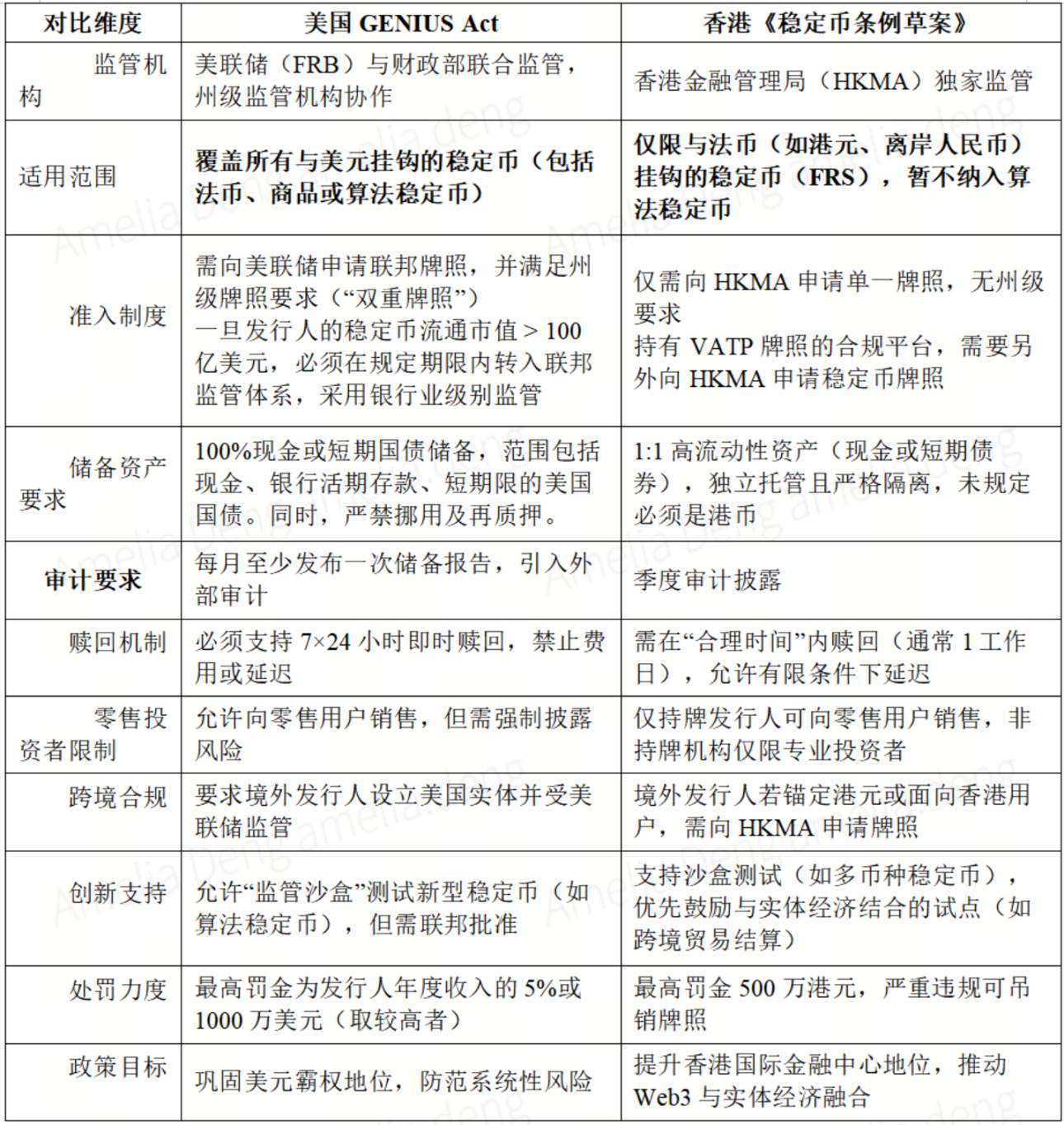Written by: Jeffrey Ding, Chief Analyst at HashKey Group
First published in Wen Hui Bao
With the stablecoin-related bills in the United States and Hong Kong, the global digital asset market has officially entered a new growth cycle driven by regulation. The implementation of these regulations not only fills and improves the regulatory blank for fiat-pegged stablecoins but also provides the market with a clear compliance framework, including reserve asset isolation, redemption guarantees, and anti-money laundering requirements, effectively reducing systemic risks (such as bank runs or fraud).
This article analyzes the core frameworks of two major bills, combined with quantitative predictions, systematically exploring the ten-year growth trajectory of compliant US dollar stablecoins and their reconstruction effect on public chain ecosystems.
I. Growth Momentum and Quantitative Simulation of US Dollar Stablecoins under the GENIUS Act
The US GENIUS Act (Guiding and Establishing National Innovation for U.S. Stablecoins Act) was passed in the Senate in May 2025, marking a key step in US stablecoin regulation. The act establishes a detailed regulatory framework for stablecoin issuers, requiring them to hold reserves of at least 1:1 backed by high-liquidity assets such as US dollar cash, short-term US Treasury bonds, or government money market funds, and to undergo regular audits while complying with anti-money laundering (AML) and know-your-customer (KYC) requirements. Additionally, the act prohibits stablecoins from providing interest income, limits foreign issuers from entering the US market, and clearly defines stablecoins as neither securities nor commodities, thus providing a clear legal positioning for digital assets. This legislation aims to enhance consumer protection, prevent financial risks, and provide a stable regulatory environment for financial technology innovation.
The implementation of the GENIUS Act is expected to have a profound impact on the global crypto market landscape. First, investing in non-interest-bearing, high-liquidity US dollar assets will directly benefit US Treasury bond issuance, making stablecoins an important distribution channel for US bonds. This mechanism not only alleviates the US fiscal deficit financing pressure but also strengthens the US dollar's international settlement status through digital currency channels. Second, a clear regulatory framework may attract more financial institutions and tech companies to enter the stablecoin field, promoting payment system innovation and efficiency. However, the act has also sparked controversy, such as potential conflicts of interest from the Trump family's involvement in the crypto industry and international regulatory coordination issues from restrictions on foreign issuers. Despite this, the GENIUS Act provides institutional guarantees for stablecoin development, marking an important step for the US in global digital asset regulatory competition.
According to Citigroup's prediction, under a scenario of clear regulatory pathways, the global stablecoin market value will grow from $230 billion in 2025 to $1.6 trillion in 2030. Notably, this prediction implies two key assumptions: first, compliant stablecoins will accelerate the replacement of traditional cross-border payment channels, saving approximately $40 billion in international remittance costs annually; second, stablecoin lock-up volume in DeFi protocols will exceed $500 billion, becoming the basic liquidity layer of decentralized finance.
II. Hong Kong's Differentiated Positioning in Stablecoin Regulation
The recent Stablecoin Ordinance issued by the Hong Kong Special Administrative Region government marks a significant progress in its systematic layout in the Web3.0 field. The ordinance establishes a licensing system for stablecoin issuance, requiring issuers to obtain a permit from the Hong Kong Monetary Authority (HKMA) and meet strict requirements in reserve asset management, redemption mechanisms, and risk control. Additionally, Hong Kong plans to introduce a dual licensing system for over-the-counter (OTC) and custody services in the next two years, further improving the full-chain regulation of virtual assets. These measures aim to strengthen investor protection, enhance market transparency, and consolidate Hong Kong's position as a global digital asset center.
The Hong Kong Monetary Authority plans to release operational guidelines for real-world asset (RWA) tokenization in 2025, promoting the on-chain tokenization process of traditional assets such as bonds, real estate, and commodities. Through smart contract technology, achieving functions like automatic dividend and interest distribution, Hong Kong is committed to building an innovative ecosystem that integrates traditional finance with blockchain technology, opening up broader application spaces for Web3.0. Under Hong Kong's regulatory framework, stablecoin issuance will present a prosperous development trend of multi-currency and multi-scenario applications, further consolidating Hong Kong's position as a technological financial hub.
While the Hong Kong Stablecoin Ordinance Draft borrows from US regulatory logic, it shows significant differences in implementation details (see Table 1):

Table 1: Comparison of US and Hong Kong Stablecoin Regulatory Frameworks
III. Global Stablecoin Landscape Evolution under Regulatory Cooperation and Competition
(I) Global Reserve Currency Strengthening Effect of US Dollar Stablecoins
Under the regulatory framework established by the GENIUS Act, payment-type stablecoins must use US Treasury bonds as reserve assets, giving US dollar stablecoins strategic significance beyond digital currencies. Essentially, these stablecoins have become a new distribution channel for US Treasury bonds, constructing a unique global fund circulation system: when global users purchase stablecoins denominated in US dollars, issuers must allocate corresponding funds to US bond assets, not only achieving fund flow back to the US Treasury but also invisibly strengthening the global usage breadth of the US dollar. This mechanism can be viewed as a global extension of US dollar financial infrastructure.
From an international settlement perspective, the emergence of stablecoins marks a paradigm shift in the US dollar clearing system. In the traditional model, US dollar cross-border flow heavily relied on bank settlement networks like SWIFT, while blockchain-based stablecoins directly embed various compatible distributed payment systems in the form of "on-chain dollars". This technological breakthrough eliminates the limitations of US dollar settlement capabilities imposed by traditional financial institutions. This not only expands the international usage scenarios of the US dollar but also represents the modernization upgrade of US dollar settlement sovereignty in the digital era, further consolidating its core position in the global monetary system.
(II) Regulatory Coordination Challenges between Hong Kong and Singapore
Although Hong Kong has established a stablecoin licensing system first, the Monetary Authority of Singapore (MAS) has simultaneously launched a "stablecoin sandbox" allowing experimental issuance of tokens pegged to existing fiat currencies. Regulatory arbitrage between the two locations may trigger issuer "regulatory site selection" behaviors, requiring the establishment of unified reserve audit standards and anti-money laundering information sharing mechanisms through the ASEAN Financial Regulatory Forum.
While Hong Kong and Singapore have similar goals in stablecoin regulatory policies, their implementation paths show significant differences. Hong Kong adopts a cautious and tightening regulatory approach, with the HKMA planning to establish a statutory stablecoin license system, positioning stablecoins as "virtual bank alternatives" and strictly following traditional financial regulatory frameworks. In contrast, Singapore maintains an experimental regulatory philosophy, allowing innovative pilot tests of digital tokens pegged to fiat currencies, reserving flexibility for technological and business model innovations, and generally adopting a tolerant trial-and-error regulatory attitude.
These regulatory differences may lead to selective registration by issuers to avoid strict scrutiny or exploit regulatory standard differences for arbitrage, thereby weakening the audit effectiveness of fiat-pegging mechanisms. In the long term, without coordination, this fragmentation could undermine regulatory fairness and policy consistency, potentially triggering regional regulatory competition risks and causing both locations to fall into internal competition. Moreover, inconsistent regulatory standards might weaken Asia's discourse power in the global stablecoin system, thereby affecting the competitiveness of Hong Kong and Singapore as international financial centers.
Regulatory authorities from both regions need to strengthen policy coordination, seeking a better balance between preventing systemic risks and encouraging financial innovation, to enhance Asia's overall influence in global digital financial governance.
Conclusion: Clear Regulation Opens the Golden Decade for Stablecoins
The joint implementation of the US GENIUS Act and Hong Kong's draft regulations marks the transition of digital asset regulation from fragmentation to systematization. Compliant USD stablecoins will achieve an order of magnitude growth within a decade, becoming the core bridge connecting traditional finance and the crypto ecosystem. The technological evolution of public chain infrastructure will determine its ability to capture the maximum value dividend within the regulatory framework. For issuers, building a multi-chain, multi-currency, and multi-regulatory compatible stablecoin system will be the key strategy to win the next decade of competition.
(Note: The data model of this article is based on the Citigroup April 2025 report, US Senate Banking Committee hearing records, and Hong Kong Monetary Authority public documents, with growth predictions considering macroeconomic volatility and technological risks.)






